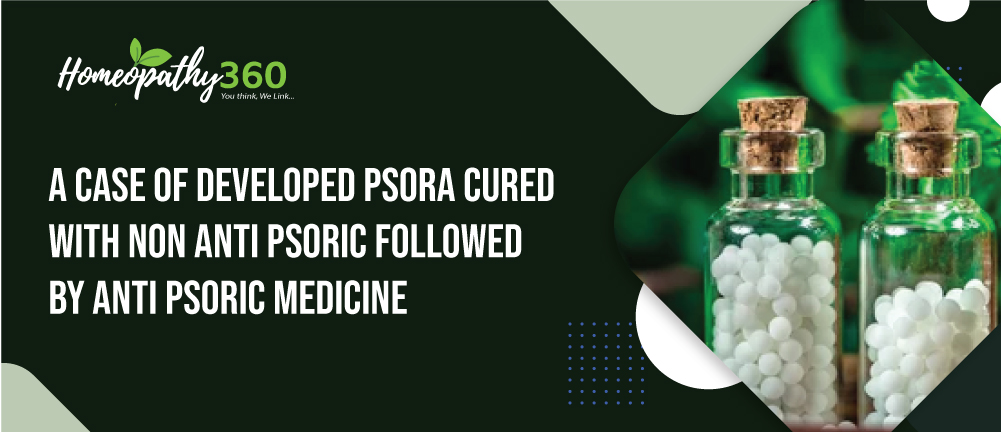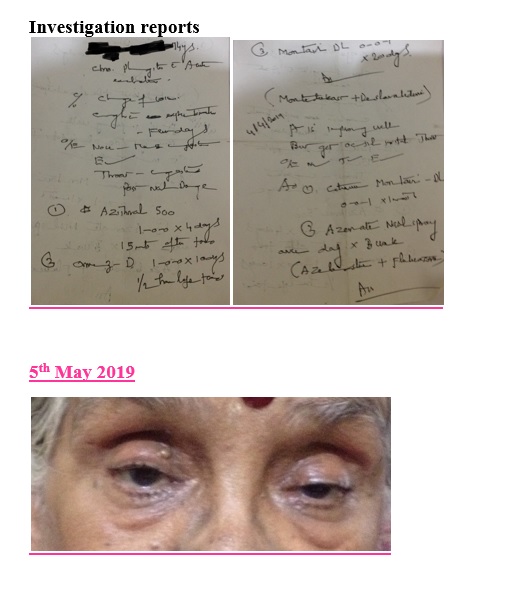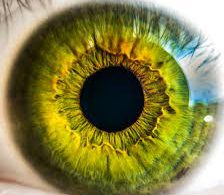
Background: According to Dr Samuel Hahnemann, the developed psoric disease should be treated with anti-psoric medicine. Introduction: Homoeopathy developed about 200 years ago by the German physician Dr Samuel Hahnemann. NCD’s especially mental disorder is brawling to show a cure in modern medicine. According to the ‘The Chronic Diseases’ and ‘Organon of Medicine’, proposed by Dr Samuel Hahnemann, the exacerbation of latent psoric stage should be treated with non-anti psoric and underlying fundamental cause should be treated with antipsoric. Materials and method: a developed chronic aponeurotic mild Ptosis and allergic asthma, chronic pharyngitis attended at private clinic. The case has been taken in detail and analysed as per the guidelines of Dr Hahnemann and maintained as hardcopy. Diagnosis made with clinical symptoms, previous prescription, inspection, comprehensive eye examination, measuring marginal reflex distance. Homoeoquest software has been used as repertorial tool and various materia medica for comparative study. Results: according to Dr Hahnemann, the cause of the chronic diseases is due to developed psora and the case has been treated with non anti psoric “Opium 200C” for the exacerbated latent psoric stage and followed with anti psoric – Sulphur 30 C rewarding cure. Conclusion: Hahnemann’s view was well established at the end. The case reports highlights the importance of psoric theory and it can be implied as a general rule in treating chronic diseases. The larger implication of the findings is the theory written in the 1800s is still valid in the 21st century.
Keywords: psora, antipsoric medicine
Abbreviations: NCDs – non-communicable diseases, ICD – International Classification of Diseases, MRD – marginal reflex distance
Introduction
Acquired ptosis of left eyelid is recognised by the following codes ICD-10 – H02.4 – ptosis of eyelid – H02.402 as per the International Classification of Diseases (ICD) nomenclature. Ptosis is the drooping of the upper eyelid margin. It is a common cause of reversible peripheral vision loss that affects the superior visual field first and then can go on to affect central vision [1]. It can be either originated since birth (congenital) or developed over the time of his/her life (acquired). The common classification is based on aetiology – myogenic, neurogenic, aponeurotic (senile), mechanical and traumatic. Apo neurotic ptosis is a very common condition in elderly interrupting their vision functionally and cosmetically.
A community study [2] on elderly revealed forty-six (11.5%) had ptosis and its prevalence increased with age. Ptosis was bilateral in 18 (39%) and unilateral in 28 (61%) thus revealing its importance to find a cure for it. In all but four cases, the ptosis was acquired. Surgery is the common conventional treatment but sometimes with complications such as over correction or under correction with a patient dissatisfaction of around 25%. Other complications are xerophthalmia and ocular injury.
Though low in percentage of prevalence, the disruption to lead a normal life in old age needs medical interruption to get arrested. NCD’s has no cure to be shown effective in modern allopathy while alternative system like homoeopathy is proving to be beneficial. This is a case of chronic disease cured by homoeopathic non-antipsoric followed by antipsoric medicine as per the observations described in Dr Hahnemann’s book ‘The Chronic Diseases’ [3], [4], [5] and in ‘Organon of Medicine’ [6]. This case has been chosen to prove efficacy of Hahnemann’s methodology in treating NCD’s.
Presenting complaints
Name: Y
Age: 74 years
Sex: female
Occupation: housewife
Status: widow
- Unilateral mild drooping of eyelids of left eye. Left canthi sticking sensation. Started 3 years back.
- Allergic coryza since childhood – cetrizine as SOS past 20 years. Chronic pharyngitis, had to hem and hawk to get mucous with change of voice. If complaints aggravates, then asthma with slight wheezing and chest congestion and had to take antibiotics. < dust, snow, cold climate.
Medication history
History of hypertension – on tablet losar 25mg and neurobion daily once (desire to continue it and she needs to treat only for eye drooping and allergic asthma). On tablet montair and azonate nasal spray daily once for allergy. Her sister was a ophthalmologist and advised for surgery. To avoid surgery, sought homoeopathy.
Past history of complaints in chronological order
- Infancy – vaccination
- Coryza – since childhood
- Chicken pox – 36 years
- Asthma and allergy increased – 54 years
- Hypertension –58 years
- Husband expired – 58 years
- Mental shock – 66 years
- Ptosis – 71 years.
Family History
- Father – allergy
- Elder brother – depression
- Younger brother – liver cirrhosis
- Allergy/asthma
Peculiarities of altered physiology
In general, her thirst increased with less appetite and desire for sweet. Nothing particular about urine and stool with one sided sweat on back. 1 hour sleep enough since childhood. Sensitive to heat in general.
Mind
Happy life. Contented by nature. Desire to be busy. Religious. Sensitive to criticism. Always take opinion of sister – dependent. Suppressed anger on contradiction and when in sickness by talking to self. Becomes more confident by living independently. Temperament – sanguine
Diagnosis of the case [1]
Apneurotic unilateral senile mild ptosis, allergic asthma and chronic pharyngitis.
Diagnosis: clinical symptoms, inspection – facial asymmetry as eyelids were drooped, the ridge of the left eyelid margin was not so strong like right eye, comprehensive eye examination, measuring marginal reflex distance – MRD 1 (distance from centre of pupil to margin of eyelid of eye with ptosis is compared with normal eye) [7]. Normal is 4 -5 mm; she had mild ptosis with less than 2 mm. Photographs on primary position.
Differential diagnosis: ruled out third nerve palsy, Horner’s syndrome, and myasthenia gravis based on symptom gravity.
Prognosis: functional disability and aesthetic issues.
Case analysis
The strong family history points the role of ancient posra. The mental shock has triggered it further from respiratory organ to eye.
- ‘The Chronic diseases’: advanced age, shock, daily vexation and annoyance which embitter the life can develop psora. Developed psoric symptoms – eyelids are heavy as if paralyzed, coryza, hoarseness, and asthma [8].
- ‘Organon of medicine’ (78 FN): “…in later years, after adverse events and conditions of life, they are sure to appear anew and develop the more rapidly and assume a more serious character…[9]”
Medicine should cover initially the recent grief and immediate pathology – a non-anti-psoric medicine followed with anti-psoric for childhood allergy.
Repertorisation of totality of symptoms
Rubrics fromHomeoquest software [10]
- Eyelids, paralysis, drooping, ptosis, etc, upper, left – pathological symptom
- Contented – unaffected mind disposition and current mental status are same in this case.
- Sleeplessness, in general – altered physiological symptom
- Ailments from fright – causation for developing psora
Medicines
| Non anti psoric | Anti posric |
| Opium – 9/3 | Graphites- 7/3 |
| Aconitum napellus – 7/2 | Sepia – 7/2 |
| Pulsatilla nigricans – 7/2 | Aurum metallicum – 6/3 |
| Gelsemium sempervirens – 7/2 | Lycopodium clavatum – 6/3 |
Prescription
03.05.2019 -Prescription: Placebo
Adjuvant therapy: breathing technique in yoga to improve the vital energy.
Follow –up
| Date | Follow up | Medicine prescribed | Reason |
| 08.05.2019 | Ear feeling closed as if and dyspnoea Dyspnoea when gas forms in stomachVertigo when too much gas in stomach – tablet Raxo – 20 mg once in 3 month for past 5 years. Recently added more garlic in diet.No change in eye drooping.Stopped montair and azonate spray: stopped as it is over and already started homoeopathic medicine.Left upper eyebrow pain– better | Opium 200 one dose | Considering the psychic cause considered non antipsorics – Opium, Aconitum napellus, Gelsemium sempervirens and Pulsatilla nigricans. Opium scored the highest matching to her presenting complaints. Ruled out:- Aconitum napellus: as it is indicated more when turmoil in circulation as an anti phlogistic remedy. Gelsemium sempervirens: as no key symptom features of dizziness or drowsiness. Pulsatilla nigricans: as contented disposition markedly contradict. Materia medica Kent [11] – A mental state appears in these constitutions. Fear and its results; one sided paralysis; great happiness; sleeplessness.The Chronic diseases– fright, especially when the fright causes timidity, when fearfulness remains after fright. |
| 17.06. 2019 | Left upper eyebrow pain – nilLeft upper eye lid – slightly averted backDyspnoea and pharyngitis better Gastric problem betterNo vertigo Ear and nose block occasionally. Discharge from ear. Went for eye test of cataract – No cataract but ophthalmologist prescribed latanoprost ophthalmic solution 1 drop daily suspecting pressure in eye till august 2019. | Placebo | Case improving |
| 15. 06.2019 | Discharge from ear – 90% betterPharyngitis better. Eye- feeling like now its easy to open eyes.Latanoprost eye drops over and stopped.Dyspnoea when gastric problem but no vertigoConstipation same | Opium 200 – one dose | Justification -Constipation and dyspnoea persist so repeated Opium. |
| 28.08.2019 | Eye drooping – nilAsthma – Asthalin 2 mg in night. ConstipationGas troubleThroat irritation | Sulphur 30 – one dose | Justification – Except eye drooping, other few symptoms remained which suggests the element of inherited psora being originated from childhood. Hence need to be combated with anti psoric. Respiration difficult, constipation and sore throat were leading to Sulphur. |
| 10.10.2019 | No complaintsEye strength sustainedTaken antibiotics for fever without my knowledge. | Sulphur 200 one dose | To sustain the result if antibiotics has interfered the treatment. |
| 05. 11.2019 | Eyes – maintaining status co. Now it is same as of right eye. The ridge of left eyelid margin gained strength similar to right eye. No other symptoms. Not on any medication. | Placebo | Saved from surgery. Case closed and not relapsed till recently. |
Investigation reports


Repertorial chart
| Rubric | Intensity | op | graph | acon | gels | puls | sep | aur | lyc | verat | bor |
| Total | 9 | 7 | 7 | 7 | 7 | 7 | 6 | 6 | 6 | 6 | |
| Rubrics Covered | 3 | 3 | 2 | 2 | 2 | 2 | 3 | 3 | 3 | 2 | |
| Knerr’s Repertory of Hering’s Guiding Symptoms::Mind and Disposition Fear (alarm, fearfulness, fright, timidity); Ailments from (including fright) | 1 | 4 | 3 | 4 | 4 | 3 | 3 | 3 | 3 | 3 | – |
| Boenninghausen’s Repertory (by Boger C.M.)::Sleep Sleeplessness; In general | 1 | 3 | 3 | 3 | 3 | 4 | 4 | 2 | 2 | 2 | 3 |
| Boenninghausen’s Repertory (by Boger C.M.)::Mind Contented | 1 | 2 | – | – | – | – | – | 1 | – | – | 3 |
| Boenninghausen’s Repertory (by Boger C.M.)::Eyes Eyelids; Paralysis, drooping, ptosis, etc.; Upper; Left | 1 | – | 1 | – | – | – | – | – | 1 | 1 | – |
Conclusion
This case clearly pointed out the supremacy in following Hahnemann’s methodology of treating chronic diseases in developed NCDs. One of the difficulties faced was incompleteness of repertories. Only exact rubrics were considered hence has to depend on several repertories to get exact simile. Classifying disease according to acute exacerbation of latent psora and later developed psora and then curing according to Dr Hahnemann’s methodology is the uniqueness of the case report.
References
1. Javier Galván Molina, MD, Anne Barmettler, MD, Michael T Yen, MD, Andrew Ines, MD, Marcus M. Marcet, MD, Cat Nguyen Burkat, MD FACS. “Aponeurotic Ptosis” on July 15, 2021. Available from: https://eyewiki.aao.org/Aponeurotic_Ptosis.
2. GV Sridharan, RC Tallis, BL eatherbarrow, WM Forman. “A community survey of ptosis of the eyelid and pupil size of elderly people -https://pubmed.ncbi.nlm.nih.gov/7762457/
- S. Hahnemann (1835). “Die chronischen Krankheiten, ihre eigeirthümliche Natur und homöopathische Heilung”; Second edition.
- Charles J Hempal MD (1845) “The chronic diseases: their specific nature And Homoeopathic cure”, first edition.
- Louis h. Tafel (1835). “The Chronic Diseases, their peculiar nature and their homceopathic cure”; from the second enlarged German edition.
- R. E. Dudgeon. “The Organon of Medicine” translated by, 31st impression 2014 published by B Jain.
7. Daniel Oh, MD, Anne Barmettler, MD, Michael T Yen, MD, Cat Nguyen Burkat, MD FACS, “Margin to Reflex Distance 1,2,3” April 27, 2021, Available from https://eyewiki.aao.org/Margin_to_reflex_distance_1,2,3.
- Louis h. Tafel (1835). “The Chronic Diseases, their peculiar nature and their homoeopathic cure”; from the second enlarged German edition.
- R. E. Dudgeon. “The Organon of Medicine” translated by, 31st impression 2014 published by B Jain.
- Homeoquest2014, community core level 5, version 14.2.1. Available from: http://www.homeoquest.com/
- George Vithoulkas, International Academy of Classical Homeopathy, “Opium” by Kent. Available from https://www.vithoulkas.com/learning-tools/materia-medica-kent/opium
About the author
Dr Anaswara Dev, BHMS, M Sc. Psychology, NYT.
First prize winner of first international AYUSH conclave held at Kerala (IACK 2019) for statistical research Paper. Presented literature research paper at 4th largest International Integrative Oncology ICIO 2020 by GHF in association with Ministry of AYUSH, Govt. of India.





